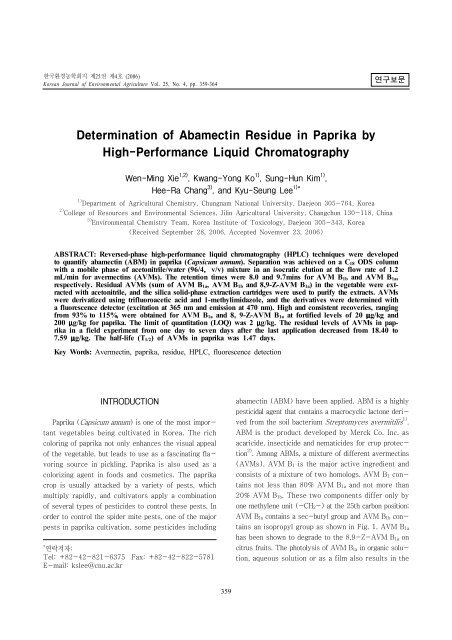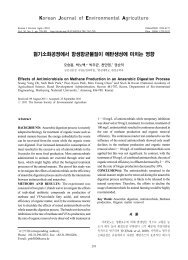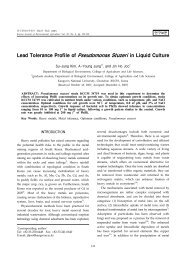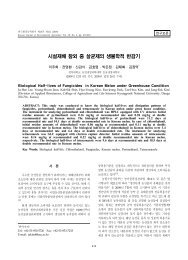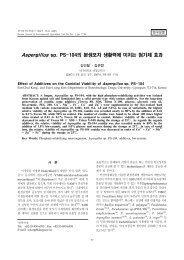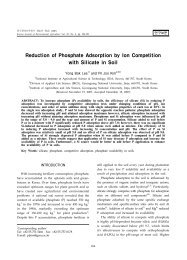Determination of Abamectin Residue in Paprika by High ...
Determination of Abamectin Residue in Paprika by High ...
Determination of Abamectin Residue in Paprika by High ...
Create successful ePaper yourself
Turn your PDF publications into a flip-book with our unique Google optimized e-Paper software.
한국환경농학회지 제25권 제4 호 (2006)<br />
Korean Journal <strong>of</strong> Environmental Agriculture Vol. 25, No. 4, pp. 359-364<br />
연구보문<br />
<strong>Determ<strong>in</strong>ation</strong> <strong>of</strong> <strong>Abamect<strong>in</strong></strong> <strong>Residue</strong> <strong>in</strong> <strong>Paprika</strong> <strong>by</strong><br />
<strong>High</strong>-Performance Liquid Chromatography<br />
Wen-M<strong>in</strong>g Xie 1,2) , Kwang-Yong Ko 1) , Sung-Hun Kim 1) ,<br />
Hee-Ra Chang 3) , and Kyu-Seung Lee 1)*<br />
1) Department <strong>of</strong> Agricultural Chemistry, Chungnam National University, Daejeon 305-764, Korea<br />
2) College <strong>of</strong> Resources and Environmental Sciences, Jil<strong>in</strong> Agricultural University, Changchun 130-118, Ch<strong>in</strong>a<br />
3) Environmental Chemistry Team, Korea Institute <strong>of</strong> Toxicology, Daejeon 305-343, Korea<br />
(Received September 28, 2006, Accepted Novemver 23, 2006)<br />
ABSTRACT: Reversed-phase high-performance liquid chromatography (HPLC) techniques were developed<br />
to quantify abamect<strong>in</strong> (ABM) <strong>in</strong> paprika (Capsicum annum). Separation was achieved on a C 18 ODS column<br />
with a mobile phase <strong>of</strong> acetonitrile/water (96/4,<br />
v/v) mixture <strong>in</strong> an isocratic elution at the flow rate <strong>of</strong> 1.2<br />
mL/m<strong>in</strong> for avermect<strong>in</strong>s (AVMs). The retention times were 8.0 and 9.7m<strong>in</strong>s for AVM B 1b and AVM B 1a ,<br />
respectively. Residual AVMs (sum <strong>of</strong> AVM B 1a, AVM B 1b and 8,9-Z-AVM B 1a) <strong>in</strong> the vegetable were extracted<br />
with acetonitrile, and the silica solid-phase extraction cartridges were used to purify the extracts. AVMs<br />
were derivatized us<strong>in</strong>g trifluoroacetic acid and 1-methylimidazole, and the derivatives were determ<strong>in</strong>ed with<br />
a fluorescence detector (excitation at 365 nm and emission at 470 nm). <strong>High</strong> and consistent recoveries, rang<strong>in</strong>g<br />
from 93% to 115%, were obta<strong>in</strong>ed for AVM B 1a and 8, 9-Z-AVM B 1a at fortified levels <strong>of</strong> 20 μg/kg and<br />
200 μ g/kg for paprika. The limit <strong>of</strong> quantitation (LOQ) was 2 μ g/kg. The residual levels <strong>of</strong> AVMs <strong>in</strong> pap-<br />
rika <strong>in</strong> a field experiment from one day to seven days after the last application decreased from 18.40 to<br />
7.59 μg/kg. The half-life (T1/2) <strong>of</strong> AVMs <strong>in</strong> paprika was 1.47 days.<br />
Key Words: Avermect<strong>in</strong>, paprika, residue, HPLC, fluorescence detection<br />
INTRODUCTION<br />
<strong>Paprika</strong> (Capsicum annum) is one <strong>of</strong> the most important<br />
vegetables be<strong>in</strong>g cultivated <strong>in</strong> Korea. The rich<br />
color<strong>in</strong>g <strong>of</strong> paprika not only enhances the visual appeal<br />
<strong>of</strong> the vegetable, but leads to use as a fasc<strong>in</strong>at<strong>in</strong>g flavor<strong>in</strong>g<br />
source <strong>in</strong> pickl<strong>in</strong>g. <strong>Paprika</strong> is also used as a<br />
coloriz<strong>in</strong>g agent <strong>in</strong> foods and cosmetics. The paprika<br />
crop is usually attacked <strong>by</strong> a variety <strong>of</strong> pests, which<br />
multiply rapidly, and cultivators apply a comb<strong>in</strong>ation<br />
<strong>of</strong> several types <strong>of</strong> pesticides to control these pests. In<br />
order to control the spider mite pests, one <strong>of</strong> the major<br />
pests <strong>in</strong> paprika cultivation, some pesticides <strong>in</strong>clud<strong>in</strong>g<br />
* 연락저자:<br />
Tel: +82-42-821-6375 Fax: +82-42-822-5781<br />
E-mail: kslee@cnu.ac.kr<br />
abamect<strong>in</strong> (ABM) have been applied. ABM is a highly<br />
pesticidal agent that conta<strong>in</strong>s a macrocyclic lactone derived<br />
from the soil bacterium Streptomyces avermitilis 1) .<br />
ABM is the product developed <strong>by</strong> Merck Co. Inc. as<br />
acaricide, <strong>in</strong>secticide and nematicides for crop protection<br />
2) . Among ABMs, a mixture <strong>of</strong> different avermect<strong>in</strong>s<br />
(AVMs), AVM B 1 is the major active <strong>in</strong>gredient and<br />
consists <strong>of</strong> a mixture <strong>of</strong> two homologs. AVM B 1 conta<strong>in</strong>s<br />
not less than 80% AVM B 1a and not more than<br />
20% AVM B 1b. These two components differ only <strong>by</strong><br />
one methylene unit (-CH 2-) at the 25th carbon position;<br />
AVM B 1a conta<strong>in</strong>s a sec-butyl group and AVM B 1b conta<strong>in</strong>s<br />
an isopropyl group as shown <strong>in</strong> Fig. 1. AVM B 1a<br />
has been shown to degrade to the 8,9-Z-AVM B 1a on<br />
citrus fruits. The photolysis <strong>of</strong> AVM B 1a <strong>in</strong> organic solution,<br />
aqueous solution or as a film also results <strong>in</strong> the<br />
359
360<br />
Wen-M<strong>in</strong>g Xie, Kwang-Yong Ko, Sung-Hun Kim, Hee-Ra Chang, and Kyu-Seung Lee<br />
H 3 O<br />
O<br />
HO<br />
O<br />
O<br />
CH CH 3<br />
H<br />
H CH 3<br />
H<br />
3 C<br />
O<br />
O<br />
H 3 C O<br />
H 3 C<br />
H O O<br />
AVM B 1 a: R=C 2 H 5<br />
AVM B 1 b: R=CH 3<br />
O<br />
formation <strong>of</strong> 8, 9-Z-AVM B 1a. Most AVMs are highly<br />
lipophilic substances and are dissolved <strong>in</strong> most organic<br />
solvents, but are poorly soluble <strong>in</strong> water 3) . In the environment,<br />
AVMs are quickly degraded (half-life,<br />
4-21 h) <strong>by</strong> oxidative and photo-oxidative mechanisms<br />
when exposed to light <strong>in</strong> water on a th<strong>in</strong> biological<br />
surfaces (e.g. leave) or bounded to the soil particles 4) .<br />
The high molecular weight <strong>of</strong> the AVMs (>800<br />
daltons) leads liquid chromatography as the most suitable<br />
chromatographic technique for determ<strong>in</strong>ation. Liquid<br />
chromatographic methods us<strong>in</strong>g ultraviolet (UV)<br />
detection and fluorescence detection for the AVMs<br />
residue <strong>in</strong> different k<strong>in</strong>d samples were reported. Johan<br />
described the determ<strong>in</strong>ation <strong>of</strong> AVMs <strong>in</strong> lettuce and<br />
cucumber <strong>by</strong> high performance liquid chromatography<br />
(HPLC) with UV detector 5) . However, the method was<br />
not sensitive enough (limit <strong>of</strong> detection 40 μg/kg). So,<br />
HPLC with fluorescence detection follow<strong>in</strong>g a fluorescent<br />
derivatization <strong>of</strong> the parent compounds us<strong>in</strong>g<br />
trifluoroacetic acid and a basic catalyst (such as methylimidazole)<br />
has been a common analytical method for<br />
monitor<strong>in</strong>g ABM residues <strong>in</strong> tissue, milk, fruits, and<br />
vegetables 6-10) . Liquid chromatography/tandem mass<br />
spectrometry (LC/MS/MS) analysis was developed<br />
for the determ<strong>in</strong>ation <strong>of</strong> AVMs <strong>in</strong> milk, liver, muscle,<br />
and food commodities 11-15) . The ELISA method was<br />
also used to detect ABM, IVM, and EPR residues <strong>in</strong><br />
bov<strong>in</strong>e liver tissues, with a limit <strong>of</strong> quantization <strong>of</strong> 1.06<br />
ng/mL for all k<strong>in</strong>ds <strong>of</strong> three AVMs 16) .<br />
OH<br />
HO<br />
H<br />
CH 3<br />
H<br />
H<br />
CH 3<br />
R<br />
O<br />
H<br />
CH 3<br />
Of all above methods, fluorescence detection <strong>of</strong>fered<br />
the most specific method with the lowest detection<br />
limit. However, the methods published have been<br />
applied for measurements <strong>in</strong> complex matrices like<br />
plants and animal tissues. The very low concentrations<br />
<strong>in</strong> these tissues required a very laborious procedure<br />
<strong>in</strong>clud<strong>in</strong>g extraction, several clean-up steps, and derivatization<br />
before f<strong>in</strong>al HPLC-fluorescence detection. So<br />
C H 3<br />
CH 3<br />
O<br />
O<br />
OH<br />
HO<br />
CH 3<br />
O<br />
H<br />
CH 3<br />
H<br />
8, 9-Z-AVM B 1 a<br />
Fig. 1. Chemical structures <strong>of</strong> avermect<strong>in</strong> B 1a, , B 1b and<br />
8,9-Z-avermect<strong>in</strong> B 1a.<br />
1a<br />
the ma<strong>in</strong> purpose <strong>of</strong> this study was to develop a rapid,<br />
sensitive, and quantitative technique for the determ<strong>in</strong>ation<br />
<strong>of</strong> AVMs <strong>in</strong> paprika. S<strong>in</strong>ce concentration <strong>of</strong> the<br />
sample extracts <strong>of</strong>ten led to severe <strong>in</strong>terference <strong>by</strong><br />
concurrent co-extracts, rigorous purification <strong>of</strong> sample<br />
extracts must be required. Therefore, this study was<br />
ma<strong>in</strong>ly focused on the development <strong>of</strong> an efficient but<br />
simple analysis method to detect the residual level<br />
and clarification the dissipation patterns <strong>of</strong> AVMs residue<br />
<strong>in</strong> paprika under greenhouse condition.<br />
Sample preparation<br />
EXPERIMENT<br />
The field experiment on paprika was conducted<br />
under greenhouse condition at Bulgok-Myeon, Deajeon<br />
City <strong>of</strong> Korea <strong>in</strong> 2004. The paprika seedl<strong>in</strong>gs were<br />
transplanted <strong>in</strong> the middle <strong>of</strong> June. The plots were<br />
randomly distributed <strong>in</strong> the greenhouse, and the temperature<br />
was kept at 13-33 ℃ and the humidity at 66-<br />
100%. <strong>Abamect<strong>in</strong></strong> (EC, 20% a.i.), was applied as 2000-<br />
time dilute spray with water when mite outbreak was<br />
found <strong>in</strong> September. There were a total <strong>of</strong> three applications<br />
with the <strong>in</strong>terval <strong>of</strong> seven days before the fruits<br />
were sampled for residue analysis after the last application.<br />
Each treatment, <strong>in</strong>clud<strong>in</strong>g control, was replicated<br />
four times <strong>in</strong> a randomized block design. <strong>Paprika</strong><br />
samples were plucked randomly from each treatment<br />
at different time <strong>in</strong>tervals (1, 3, 5 and 7 days). Approximately<br />
500 g <strong>of</strong> the sample homogenate was reta<strong>in</strong>ed<br />
<strong>in</strong> the labeled plastic bags. The samples were stored<br />
at or below -24℃<br />
until analyzed. Before subsampl<strong>in</strong>g<br />
for analysis, the samples were partially thawed and<br />
mixed thoroughly, whenever appropriate to ensure that<br />
a representative sample was aliquoted.<br />
Reagents and equipment<br />
All reagents were analytical quality. Water, methanol,<br />
and acetonitrile (UV and pesticide residue grade)<br />
were obta<strong>in</strong>ed from Burdick & Jackson (Muskegon,<br />
USA). Trifluoroacetic anhydride and 1-methylimidazole<br />
were obta<strong>in</strong>ed from Sigma (St. Louis, MO, USA). The<br />
solid-phase extraction was done with Sep-Pak Vac<br />
silica cartridges (1,000 mg, 8 mL) obta<strong>in</strong>ed from Waters<br />
Associates (Milford, MA).The AVM standard conta<strong>in</strong><strong>in</strong>g<br />
85.5% w/w AVM B 1a and 6.9% w/w AVM B 1b was<br />
obta<strong>in</strong>ed from Syngenta AG NOA. The degradation
<strong>Determ<strong>in</strong>ation</strong> <strong>of</strong> <strong>Abamect<strong>in</strong></strong> <strong>Residue</strong> <strong>in</strong> <strong>Paprika</strong> <strong>by</strong> <strong>High</strong>-Performance Liquid Chromatography 361<br />
compound 8, 9-Z-AVM B 1a was also supplied <strong>by</strong><br />
Syngenta.<br />
The HPLC analysis was carried out with a Shimadzu<br />
CLASS LC 10 system (Shimadzu, Kyoto, Japan) equipped<br />
with a SPD-M 10Avp photo-diode array detector <strong>in</strong> the<br />
range <strong>of</strong> 200-400 nm and an Rf-10Axl fluorescence<br />
detector. The HPLC separation was conducted us<strong>in</strong>g<br />
a Symmetry C 18 sta<strong>in</strong>less column (3.9 mm i.d.×150 mm,<br />
Waters Associates). The mobile phase was eluted with<br />
acetonitrile/water( 96/4, v/v)<br />
solution at the flow<br />
rate <strong>of</strong> 1.2 mL/m<strong>in</strong> after degass<strong>in</strong>g with Shimadzu<br />
DGU-20A 3. The column temperature was ma<strong>in</strong>ta<strong>in</strong>ed<br />
at 30 ℃ . An aliquot <strong>of</strong> 10μL was <strong>in</strong>jected us<strong>in</strong>g SIL-10 A<br />
auto-sampler.<br />
Extraction and purification<br />
To 5.00 g <strong>of</strong> homogenized sample <strong>in</strong> a flask 50 mL<br />
acetonitrile was added, and then it was extracted for<br />
30 m<strong>in</strong>utes <strong>by</strong> shak<strong>in</strong>g with a flash shaker (KMC-<br />
1205SL, Vision Scientific Co.). The extract was filtered<br />
through a Buchner funnel and the filter cake was<br />
washed with 50 mL fresh acetonitrile. The filtrate was<br />
concentrated <strong>in</strong> vacuum to 10-20 mL and transferred<br />
to a 1 L separatory funnel. To the concentrate, 10 mL<br />
<strong>of</strong> saturated sodium chloride solution and 500 mL <strong>of</strong><br />
water were added. The conta<strong>in</strong>er was washed with<br />
100 mL <strong>of</strong> dichloromethane, and the solution was<br />
poured <strong>in</strong>to the separator. Then mixture was shaken<br />
vigorously for 60 seconds and left to standard until<br />
the layers separated. The dichloromethane layer was<br />
transferred to a flask and the water layer rema<strong>in</strong>ed<br />
was extracted with another 25 ml dichloromethane<br />
and comb<strong>in</strong>ed the dichloromethane part. About 15 g<br />
<strong>of</strong> sodium sulfate was added, a stopper was placed on<br />
the flask, and the solution was shaken vigorously.<br />
Care was taken such that the extract rema<strong>in</strong>s with the<br />
sodium sulfate lese than one hour to m<strong>in</strong>imum losses<br />
<strong>of</strong> pesticides <strong>by</strong> adsorption. Then the extract was transferred<br />
to a round-bottomed flask and was evaporated<br />
to dryness on a rotary evaporator (Buchi, Rotavapor<br />
R-124) at 40 ℃ .<br />
Solid phase extraction was followed to clean up<br />
the extract based on the method described <strong>by</strong> Johan 5) ,<br />
the residue was dissolved <strong>in</strong> 2 mL <strong>of</strong> ethyl acetate<br />
and 3 mL <strong>of</strong> hexane was added to prepare 40% ethyl<br />
acetate <strong>in</strong> hexane. The contents <strong>of</strong> the round-bottomed<br />
flask were mixed and sampled to a conditioned silica<br />
cartridge. The round-bottomed flask was washed two<br />
times with 1 mL <strong>of</strong> 40% ethyl acetate <strong>in</strong> hexane, and<br />
the wash<strong>in</strong>gs were also applied to the cartridge. The<br />
cartridge was washed with 8 mL <strong>of</strong> 40% ethyl acetate<br />
<strong>in</strong> hexane and were eluted with 10 mL <strong>of</strong> 50% ethyl<br />
acetate <strong>in</strong> methanol. The last part <strong>of</strong> elute <strong>in</strong> a glass<br />
tube was evaporated to dryness with N 2 on a nitrogen<br />
evaporator (N-EVAP, Organomaion Associates, JNC,<br />
USA) at 50 ℃ .<br />
Derivatization and analysis<br />
Fluorescent derivatization was performed accord<strong>in</strong>g<br />
to the method described <strong>by</strong> Diserens 6) . Deriv<strong>in</strong>g<br />
reagent I was prepared <strong>by</strong> add<strong>in</strong>g one volume <strong>of</strong> trifluoroacetic<br />
anhydride to two volumes <strong>of</strong> acetonitrile<br />
<strong>in</strong> a brown-glass flask. Deriv<strong>in</strong>g reagent II was made<br />
<strong>by</strong> add<strong>in</strong>g one volume <strong>of</strong> 1-methylimidazole to one<br />
volume <strong>of</strong> acetonitrile <strong>in</strong> a brown-glass flask. The two<br />
reagents were stored at 4℃<br />
and prepared fresh at<br />
least once each week. For standards and samples, 300<br />
μL <strong>of</strong> the reagent I and 200 μL <strong>of</strong> the reagent II were<br />
added to the reaction vial, which was sealed with a<br />
stopper, and mixed well on vortex mixer. The react<strong>in</strong>g<br />
mixture was cooled to room temperature and the<br />
derivatives <strong>of</strong> AVMs <strong>by</strong> HPLC were determ<strong>in</strong>ed.<br />
Stock standard solutions <strong>of</strong> AVM B 1a, B 1b and 8,9-<br />
Z-AVM B 1a were prepared <strong>in</strong> acetonitrile and stored<br />
at 4 ℃ . Aliquots <strong>of</strong> the stock solution were diluted<br />
with acetonitrile to provide work<strong>in</strong>g standards rang<strong>in</strong>g<br />
from 11.9 to 1196 ng/mL for AVM B 1a and 0.966 to<br />
96.6 ng/mL for AVM B 1b.<br />
The specified standard solution conta<strong>in</strong><strong>in</strong>g AVMs<br />
was piped <strong>in</strong>to a 2 mL sampl<strong>in</strong>g vial and evaporated<br />
to dryness under a gentle stream <strong>of</strong> nitrogen. The<br />
derivatization was performed as described above.<br />
The AVM residues were identified and quantified<br />
<strong>by</strong> compar<strong>in</strong>g with the retention time and peak height<br />
<strong>of</strong> standard AVMs. It was demonstrated that derivatization<br />
<strong>of</strong> AVM B 1a and 8, 9-Z-AVM B 1a isomer<br />
produced the identical derivatives. Thus, the peak at<br />
the retention time <strong>of</strong> B 1a represents the total amount<br />
for B 1a and its degradation products. Because B 1b is<br />
about 20% <strong>of</strong> the active <strong>in</strong>gredient, its residue level<br />
is normally quite low and is always lower than the<br />
sum <strong>of</strong> AVM B 1a and 8, 9-Z-AVM B 1a residue level.<br />
Validation <strong>of</strong> analytical method<br />
Recovery experiments were conducted <strong>by</strong> us<strong>in</strong>g the
362<br />
Wen-M<strong>in</strong>g Xie, Kwang-Yong Ko, Sung-Hun Kim, Hee-Ra Chang, and Kyu-Seung Lee<br />
control samples to assess the analytical method proposed<br />
for AVMs residues. Prior to extraction, the series<br />
<strong>of</strong> the control samples were fortified with AVMs standard<br />
solution <strong>in</strong> acetonitrile at specified concentrations<br />
accord<strong>in</strong>g to the MRL <strong>in</strong> pepper and l<strong>in</strong>ear range.<br />
After stand<strong>in</strong>g for 2 hours, the analytical procedures<br />
mentioned above were carried out to produce recovery<br />
data.<br />
Method evaluation<br />
B 1a<br />
RESULTS AND DISCUSSION<br />
AVMs and the degradation compound 8, 9-Z-AVM<br />
were determ<strong>in</strong>ed <strong>in</strong> paprika us<strong>in</strong>g the HPLC<br />
method with fluorescence detector. The Fig. 2 shows<br />
the UV absorption spectra <strong>of</strong> AVM B 1a and fluorescence<br />
spectra <strong>of</strong> AVM B 1a derivative. The absorbance spectra<br />
were shown to exhibit absorbance maxima at 244 nm<br />
for AVMs and 242 nm for 8, 9-Z-AVM B 1a. Accord<strong>in</strong>g<br />
to the excitation and emission spectra <strong>of</strong> AVM, 365<br />
nm and 470 nm were chosen as excitation and emission<br />
wavelength to get the highest detection sensitivity.<br />
The RP-HPLC system used for this method provided<br />
an excellent separation for all three compounds<br />
show<strong>in</strong>g basel<strong>in</strong>e separation. The representative chromatograms<br />
<strong>of</strong> a mixture <strong>of</strong> these three compounds and<br />
their derivatives are shown <strong>in</strong> Fig.3. The derivative<br />
formation was <strong>in</strong>stantaneous 17) . When the aged reagents<br />
were used, the yield was decreased and an extra peak<br />
appeared 6) . Us<strong>in</strong>g acetonitrile-water (96:4, v/v) as mobile<br />
phase, derivatives eluted after 8.0 and 9.7 m<strong>in</strong>utes<br />
and no <strong>in</strong>terference was found <strong>in</strong> paprika extracts.<br />
The standard curves for these AVM B 1a+8, 9-AVM<br />
B 1a and AVM B 1b exhibited excellent l<strong>in</strong>earity over the<br />
follow<strong>in</strong>g concentration ranges: AVM B 1a+8, 9-AVM<br />
B 1a, 11.97-1197 ng/mL, AVM B 1b, 1-96.6 ng/mL. The<br />
l<strong>in</strong>ear ranges were selected on the basis <strong>of</strong> expected<br />
residue concentration and the MRL <strong>of</strong> ABM <strong>in</strong> paprika.<br />
The l<strong>in</strong>ear correlation coefficients <strong>of</strong> calibration<br />
curves for AVM B 1a+8, 9-Z-AVM B 1a and AVM B 1b<br />
were 0.999 and 0.998, respectively.<br />
<strong>Paprika</strong> samples spiked at two levels (20 and 200<br />
μg/kg) <strong>of</strong> ABM were analyzed three times us<strong>in</strong>g the<br />
prescribed procedure for extraction, clean-up and derivatization.<br />
The results, summarized <strong>in</strong> Table 1, <strong>in</strong>dicate<br />
that the recoveries, ranged from 93% to 115%, and the<br />
repeatability, less than 10% ,was satisfactory for trace<br />
residue analysis.<br />
The lowest level <strong>of</strong> quantitation for AVMs <strong>in</strong> paprika<br />
was calculated as 2 μg/kg for AVM B1a, <strong>in</strong>clud<strong>in</strong>g<br />
8,9-Z-AVM B 1a ,with a 5 g spik<strong>in</strong>g sample portion.<br />
Consider<strong>in</strong>g the MRLs <strong>of</strong> AVMs <strong>in</strong> most vegetables,<br />
range from 10 to 50<br />
μg/kg, the sensitivity was high<br />
enough for rout<strong>in</strong>e residue analysis <strong>of</strong> fruit and vegetable<br />
samples.<br />
Term<strong>in</strong>al residue <strong>of</strong> AVMs <strong>in</strong> the field experiment<br />
ABM has been l<strong>in</strong>ked to a wide spectrum <strong>of</strong> human<br />
health hazards, rang<strong>in</strong>g from short-term impacts to<br />
chronic impacts. Chronic health effects may occur years<br />
mV<br />
0 100 200 300 400<br />
A<br />
8 . 083<br />
B<br />
9.708<br />
Standard<br />
Sample<br />
B lank<br />
0 2 4 6 8 10 12 14<br />
M<strong>in</strong>ute<br />
Fig. 2. UV absorption spectra <strong>of</strong> avermect<strong>in</strong> (AVM) and<br />
Fig. 3. Chromatograms <strong>of</strong> AVM derivatives <strong>in</strong> standard<br />
fluorescence spectra <strong>of</strong> AVM derivative.<br />
and sample extract. A: AVM B 1b, , B: AVM B 1a+8, 9-Z-<br />
A: UV absorption spectrum <strong>of</strong> AVM B1. B and C: excitation<br />
AVM B 1a.<br />
and emission spectrum <strong>of</strong> AVM B1 derivative HPLC conditions: RP Symmetry C 18 sta<strong>in</strong>less column (3.9<br />
mm i.d.×150mm, Waters Associates). The mobile phase,<br />
consist<strong>in</strong>g <strong>of</strong> water <strong>in</strong> acetonitrile (4+96, v/v), was pumped<br />
at the total flow <strong>of</strong> 1.2 mL/m<strong>in</strong>
<strong>Determ<strong>in</strong>ation</strong> <strong>of</strong> <strong>Abamect<strong>in</strong></strong> <strong>Residue</strong> <strong>in</strong> <strong>Paprika</strong> <strong>by</strong> <strong>High</strong>-Performance Liquid Chromatography 363<br />
Table 1. Recoveries <strong>of</strong> avermect<strong>in</strong>s (AVMs) from paprika<br />
Pesticides<br />
Fortified concentration<br />
(g/kg)<br />
AVM B 1a +8, 9-Z-AVM B1a 20<br />
200<br />
AVM B 1b<br />
2<br />
20<br />
Recoveries<br />
(%)<br />
115.1, 105.1, 115.2<br />
93.3, 93.9, 93.7<br />
60.7, 60.1, 67.8<br />
115.3, 121.0, 129.0<br />
Average recoveries<br />
(%)<br />
111.8<br />
93.6<br />
62.9<br />
121.8<br />
RSD<br />
(%)<br />
5.8<br />
0.3<br />
4.3<br />
6.9<br />
Table 2. Residual levels <strong>of</strong> avermect<strong>in</strong>s (AVMs) <strong>in</strong> paprika after elapsed days <strong>of</strong> last application<br />
Days after<br />
application<br />
<strong>Residue</strong> ( μg/kg, fresh weight)<br />
AVM B 1a+8, 9-Z-AVM B 1a AVM B 1b Total<br />
1d 16.89 ± 1.22 1.42 ± 0.24 18.40 ± 1.10<br />
3d 9.40 ± 0.91 0.79 ± 0.16 10.18 ± 0.99<br />
5d 7.50 ± 0.70 0.57 ± 0.09 8.07 ± 0.66<br />
7d 7.11 ± 0.61 0.48 ± 0.11 7.59 ± 0.71<br />
Mean values <strong>of</strong> four replicates with standard deviation<br />
Regression equation<br />
(half-life, d)<br />
C=17.91e -0.47t<br />
(1.47)<br />
even after m<strong>in</strong>imal exposure to them <strong>in</strong> the environment,<br />
or result from their residues <strong>in</strong>gested through<br />
vegetables, food, and water 19) . So, an acceptable daily<br />
<strong>in</strong>take (ADI) <strong>of</strong> 0.2<br />
μg/kg body weight (b.w.) for ABM<br />
was allocated <strong>in</strong> 1994 on the basis <strong>of</strong> a no-observedadverse-effect<br />
level (NOAEL) <strong>of</strong> 120<br />
μg/kg b.w. per<br />
day <strong>in</strong> a multigenerational study <strong>of</strong> reproductive toxicity<br />
<strong>in</strong> rats, us<strong>in</strong>g a safety factor <strong>of</strong> 500. The <strong>in</strong>creased<br />
safety factor was used because <strong>of</strong> concern about<br />
the teratogenicity <strong>of</strong> the 8, 9-Z-AVM B 1a, which is a<br />
photolytic degradation product that forms a variable<br />
proportion <strong>of</strong> the residue on crops. Estimate <strong>of</strong> ADI<br />
for humans (sum <strong>of</strong> AVMs and 8.S9-Z-AVM B 1a<br />
isomer) is 2 μg/kg b.w..<br />
S<strong>in</strong>ce the presence <strong>of</strong> these residues <strong>in</strong> fruits and<br />
vegetables can affect consumer health, the regulatory<br />
authorities have established MRL that are range from<br />
0.01 to 10 mg/kg for most common vegetables and<br />
fruits. The MRL <strong>of</strong> ABM has not been established for<br />
paprika <strong>in</strong> Korea, but <strong>in</strong> Europe the MRL recommended<br />
for sweet pepper is 50 μg/kg. For this field experi-<br />
ment, the residue levels <strong>of</strong> AVMs <strong>in</strong> paprika were<br />
found to be rather lower than the MRL <strong>of</strong> sweat pepper<br />
even on the first day after application. For the<br />
untreated control, no AVMs were detected. The residual<br />
level was decreased gradually from 18.40 to 7.59<br />
μg/kg for total AVMs <strong>in</strong> the first day and seventh<br />
day after application, respectively. The T 1/2 <strong>of</strong> AVMs<br />
<strong>in</strong> paprika is 1.47 days. As only trace residue was<br />
detected <strong>in</strong> the 7-day samples (
364<br />
Wen-M<strong>in</strong>g Xie, Kwang-Yong Ko, Sung-Hun Kim, Hee-Ra Chang, and Kyu-Seung Lee<br />
abamect<strong>in</strong>. Spr<strong>in</strong>ger Verlag, New York, p, 185-200.<br />
5. Johan, V. (1991) Rapid determ<strong>in</strong>ation <strong>of</strong> abamect<strong>in</strong><br />
<strong>in</strong> lettuce and cucumber us<strong>in</strong>g high-performance<br />
liquid chromatography. Journal <strong>of</strong> Agricultural and<br />
Food Chemistry 39, 303-305<br />
6. Diserens, H. and Henzel<strong>in</strong>, M. (1999) <strong>Determ<strong>in</strong>ation</strong><br />
<strong>of</strong> abamect<strong>in</strong> residues <strong>in</strong> fruits and vegetables <strong>by</strong><br />
high-performance liquid chromatography. Journal<br />
<strong>of</strong> Chromatography A 833, 13-18.<br />
7. Roudaut, B. (1998) Multiresidue method for the<br />
determ<strong>in</strong>ation <strong>of</strong> avermect<strong>in</strong> and moxidect<strong>in</strong> residues<br />
<strong>in</strong> the liver us<strong>in</strong>g HPLC with fluorescence<br />
detection. Analyst 123, 2541-2544.<br />
8. Lucija, K., Jernej, K. and Nevenka, K. E. (2004)<br />
<strong>Determ<strong>in</strong>ation</strong> <strong>of</strong> abamect<strong>in</strong> and doramect<strong>in</strong> <strong>in</strong><br />
sheep faeces us<strong>in</strong>g HPLC with fluorescence detection.<br />
Biomedical Chromatography 18, 117-124.<br />
9. Sari, P., Sun, J. G. and Razzak, M. (2006) HPLC<br />
assay <strong>of</strong> levamisole and abamect<strong>in</strong> <strong>in</strong> sheep plasma<br />
for application to pharmacok<strong>in</strong>etic studies. Journal<br />
<strong>of</strong> Liquid Chromatography & Related Technologies<br />
29, 2277-2290.<br />
10. Dusi, G., Faggionato, E., Bertocch,i L., Facchett,I.<br />
S. and Baiguera M. (2001) <strong>Determ<strong>in</strong>ation</strong> <strong>of</strong> avermect<strong>in</strong><br />
and milbemyc<strong>in</strong> residues <strong>in</strong> milk for human<br />
consumption us<strong>in</strong>g liquid chromatography<br />
with fluorescence detection. Ind Alment-Italy 40,<br />
11-14.<br />
11. Sherri, B. T., Josze, E. R. and Wendy, C. A. and<br />
Laura, R. K. (2005) Analysis <strong>of</strong> avemect<strong>in</strong> and moxidect<strong>in</strong><br />
residues <strong>in</strong> milk <strong>by</strong> liquid chromatography–<br />
tandem mass spectrometry us<strong>in</strong>g an atmospheric<br />
pressure chemical ionization/atmospheric pressure<br />
photoionization source. Analytica Chimica Acta 529,<br />
159-165.<br />
12. Sheridan, R. and Desjard<strong>in</strong>s, L. (2006) <strong>Determ<strong>in</strong>ation</strong><br />
<strong>of</strong> abamect<strong>in</strong>, doramect<strong>in</strong>, emamect<strong>in</strong>, epr<strong>in</strong>omect<strong>in</strong>,<br />
ivermect<strong>in</strong>, and moxidect<strong>in</strong> <strong>in</strong> milk <strong>by</strong><br />
liquid chromatography electrospray tandem mass<br />
spectrometry. Journal <strong>of</strong> AOAC International 89,<br />
1088- 1094.<br />
13. Wu, Z., Li, J., Zhu, L., Luo, H. and Xu, X. (2001)<br />
Multi-residue analysis <strong>of</strong> avermect<strong>in</strong>s <strong>in</strong> sw<strong>in</strong>e<br />
liver <strong>by</strong> immunoaff<strong>in</strong>ity extraction and liquid<br />
chromatography– mass spectrometry. Journal<br />
<strong>of</strong> Chromatography B 755, 361-366.<br />
14. Hou, X. L., Li, X. W., D<strong>in</strong>g, S. Y., He, J. H., Jiang,<br />
H. Y. and Shen, J. Z. (2006) Simultaneous analysis<br />
<strong>of</strong> avemect<strong>in</strong>s <strong>in</strong> bov<strong>in</strong>e tissues <strong>by</strong> LC-MS-MS<br />
with immunoaff<strong>in</strong>ity chromatography cleanup.<br />
Chromatographia 63, 543-550.<br />
15. Hernández, F., Pozo, O. J., Sancho, J. V., Bijlsma,<br />
L., Barreda, M. and Pitarch E. (2006) Multiresidue<br />
liquid chromatography tandem mass spectrometry<br />
determ<strong>in</strong>ation <strong>of</strong> 52 non gas chromatographyamenable<br />
pesticides and metabolites <strong>in</strong> different<br />
food commodities. Journal <strong>of</strong> Chromatography A<br />
1109, 242-252.<br />
16. Shi, W. M., He, J. H. and Jiang, H. Y. (2006)<br />
<strong>Determ<strong>in</strong>ation</strong> <strong>of</strong> multiresidue <strong>of</strong> avermect<strong>in</strong>s <strong>in</strong><br />
bov<strong>in</strong>e liver <strong>by</strong> an <strong>in</strong>direct competitive ELISA.<br />
Journal <strong>of</strong> Agricultural and Food Chemistry 54, 6143-<br />
6146.<br />
17. Prabhu, S. V., Varsolona, R. J., Wehner, T.A.,<br />
Egan, R. S and Tway, P. C. (1992) Rapid and<br />
sensitive high-performance liquid chromatographic<br />
method for the quantitation <strong>of</strong> abamect<strong>in</strong> and its<br />
delta 8,9-isomer. Journal <strong>of</strong> Agricultural and Food<br />
Chemistry 40, 622-625.<br />
18. Vuik, J. (1991) Rapid determ<strong>in</strong>ation <strong>of</strong> abmect<strong>in</strong><br />
<strong>in</strong> lettuce and cucumber us<strong>in</strong>g high-performance<br />
liquid chromatography. Journal <strong>of</strong> Agricultural and<br />
Food Chemistry 39, 303-309.<br />
19. Fong, W. G., Moye, H. A., Siber, J. N. and Toth, J.<br />
P. (1999) Pesticides residues <strong>in</strong> food, John Wiley &<br />
Sons, New York, USA.p,42-43


